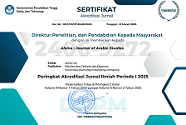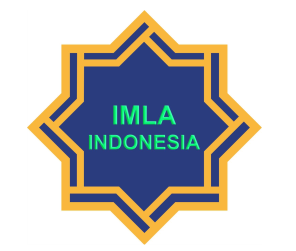Athar Istīʿāb al-Mufradāt wa-al-Qawāʿid ʿalá Kafā’at al-Kitābah al-Imlā’īyah li-al-Talāmīdh fī al-Faṣl al-Thāmin bi-Madrasat Al-Waṭanīyah al-Thānawīyah al-Islāmīyah Kebumen
DOI:
https://doi.org/10.21580/alsina.3.2.4214Keywords:
Vocabulary, Grammar, Writing, Spelling writing abilityAbstract
Many students at Wathoniyah Islamiyah Junior High School (Madrasah Tsanawiyah) Kebumen graduated from public elementary schools, so many had not have adequate knowledge of the Arabic language. This study is essential because students' diverse vocabulary and grammatical comprehension influenced their writing and spelling ability. The current study investigates the influence of vocabulary and grammatical comprehension on eighth grade students' spelling writing abilities at Wathoniyah Islamiyah Kebumen. All eighth-grade students at Wathoniyah Islamiyah Junior High School were recruited in this research. The study employed a quantitative design and purposive sampling technique to test the sample. The researchers obtained the data using documentation and analyzed the data using multiple regression tests. The results indicated that the F value is 11.250, and the F table with the value from the table at a 5% significance level = 3.385. Therefore, the F count exceeds the F table. The findings also indicated that the students' vocabulary and grammatical knowledge and comprehension have a substantial influence on their spelling and writing skill. Therefore, the research hypothesis is acceptable.Downloads
References
Al-Nemari, Hanan S. Tadrīs Al-Lughah Al-ʿArabīyah: Al-Asālīb Wa-Al-Ijrā’āt. Mecca: Ihyā’ al-Turāth al-Islāmī, 2012.
Anugrah, Rizka. Kafā’at Al-Ṭalabah Fī Mahārat Al-Kitābah: Dirāsah Waṣfīyah Fī Al-Faṣl Al-Rābiʿ Bi-Maʿhad Dār Al-Salām Gontor Li-Al-Banāt Al-Khāmis Kediri (Undergraduate Thesis). Malang: Universitas Islam Negeri Maulana Malik Ibrahim, 2014. http://etheses.uin-malang.ac.id/8819/.
Arikunto, Suharsimi. Prosedur Penelitian; Suatu Pendekatan. 15th ed. Jakarta: Rineka Cipta, 2013.
Hermawan, Acep. Metodologi Pembelajaran Bahasa Arab. Bandung: PT. Remaja Rosdakarya, 2014.
Ibrāhīm, ʿAbd al-ʿAlīm. Al-Muwajjah Al-Fannī Li-Mudarrisī Al-Lughah Al-ʿArabīyah. Cairo: Dār al-Maʿārif, 2008.
Ismāʿīl, Zakarīyā. Ṭuruq Tadrīs Al-Lughah Al-ʿArabīyah. Cairo: Dār al-Maʿrifah al-Jāmiʿīyah, 1995.
Maʻrūf, Nāyif Maḥmūd. Khaṣāʼiṣ Al-ʻArabīyah Wa-Ṭarāʼiq Tadrīsihā. Beirut: Dār al-Nafāʼis, 2008.
Malik, M. Abdul, and Dkk. Pembelajaran Bahasa Arab. Malang: UIN Malang PRESS, 2008.
Musthofa, Syaiful. Strategi Pembelajaran Bahasa Arab Inovatif. Malang: UIN-Maliki Press, 2011.
Naifah. Evaluasi Pembelajaran Bahasa Arab. Semarang: CV. Karya Abadi, 2015.
Nasional, Departemen Pendidikan. Kamus Besar Bahasa Indonesia. Jakarta: Balai Pustaka, 2001.
Rufi, Rika Anna. Belajar Menulis Permulaan Melalui Metode Struktural Analitik Sintetik. Semarang: UNNES, 2006.
Shaḥḥātah, Ḥasan. Taʿlīm Al-Lughah Al-ʿArabīyah Bayna Al-Naẓarīyah Wa-Al-Taṭbīq. Cairo: Al-Maktabah al-Miṣrīyah al-Lubnānīyah, 2008.
Sudjiono, Anas. Pengantar Statistik Pendidikan. Jakarta: Raja Grafindo Persada, 2004.
Sugiyono. Metode Penelitian Kuantitatif, Kualitatif, Dan R&D. Bandung: Alfabeta, 2017.
Ṭuʻaymah, Rushdī Aḥmad. Al-Marjaʿ Fī Taʿlīm Al-Lughah Al-ʿArabīyah Li-Al-Nāṭiqīn Bi-Lughāt Ukhrá. Mecca: Jāmiʿat Umm al-Qurá, 1986.
Zulhannan. Teknik Pembelajaran Bahasa Arab Interaktif. Jakarta: PT. Raja Grafindo Persada, 2014.
Downloads
Published
How to Cite
Issue
Section
License
Copyright
The copyright of the received article shall be assigned to the publisher of the journal. The intended copyright includes the right to publish the article in various forms (including reprints). The journal maintains the publishing rights to published articles. Authors are allowed to use their articles for any legal purposes deemed necessary without written permission from the journal, but with an acknowledgment to this journal of initial publication.
Licensing
In order for Alsina: Journal of Arabic Studies to publish and distribute research articles, the editors need publishing rights (transferred from author to publisher). This agreement relates to the transfer/publishing copyright license to Alsina: Journal of Arabic Studies but the authors still have significant rights to use and share their published articles.
Alsina: Journal of Arabic Studies supports the need for writers to share, disseminate and maximize the impact of their research and their rights on any database. As a journal article writer, you have the right to various uses of your articles, including that by the institution or company where you work. Copyright can be used without the need for special permission. Authors who publish articles in the Alsina: Journal of Arabic Studies have broad rights to use their work for teaching and scientific purposes without requesting permission, including:
- Use by the author for lectures, presentations, or conferences, with distribution of copies to participants;
- Distribution to colleagues for research use;
- Use in compilations of the author's subsequent work;
- inclusion in a thesis or dissertation;
- Reuse of sections or excerpts from articles in other works (with full acknowledgment of the final article);
- Preparation of derivative works (other than commercial purposes) (with full acknowledgment of the final article);
- Voluntary posting on open websites operated by authors’ or writers' agencies for scientific purposes
When submitting a manuscript, authors do so on the understanding that if accepted for publication, the copyright for publishing (publishing right) of the article shall be assigned/transferred to Alsina: Journal of Arabic Studies.
Authors whose articles are accepted for publication will receive confirmation via email and sent a Copyright Transfer Agreement.


 Accreditation
Accreditation 
 In Collaboration with
In Collaboration with 

 Visitors
Visitors  Article Template
Article Template





